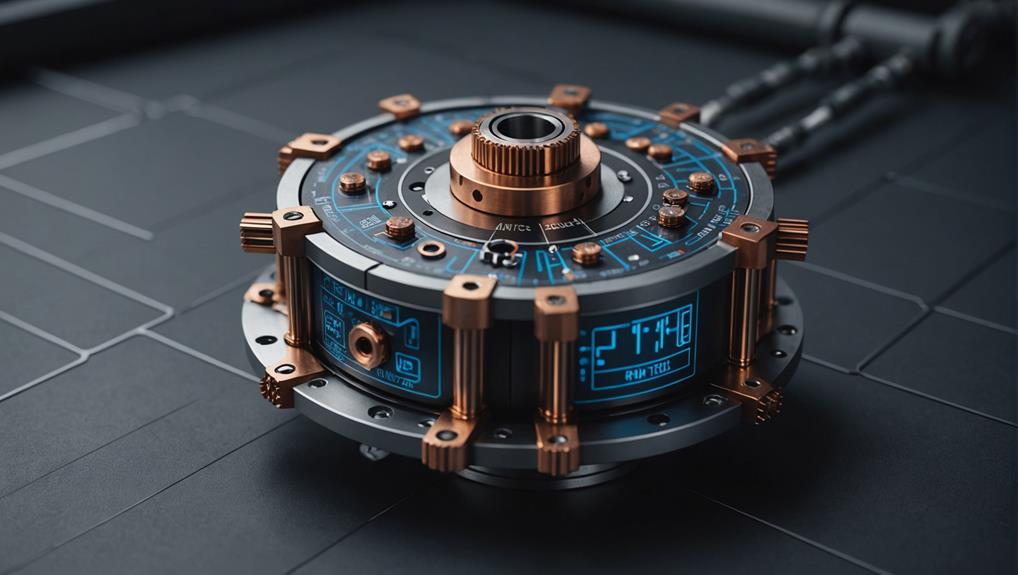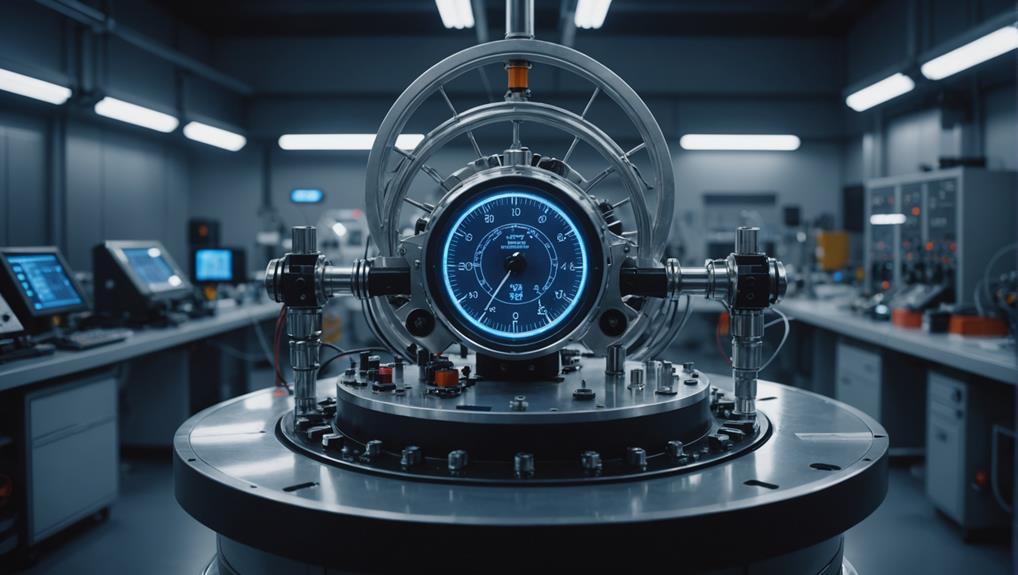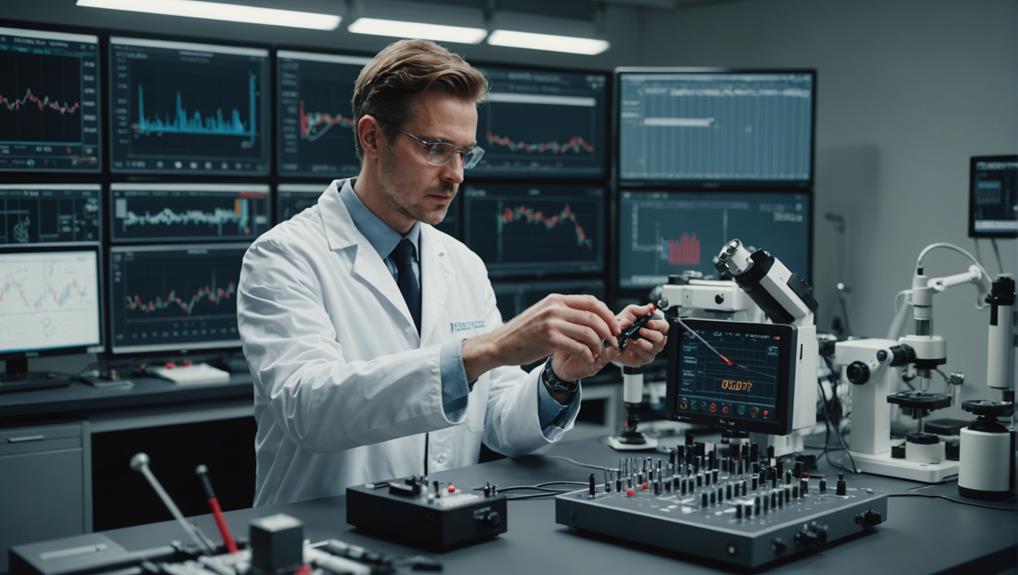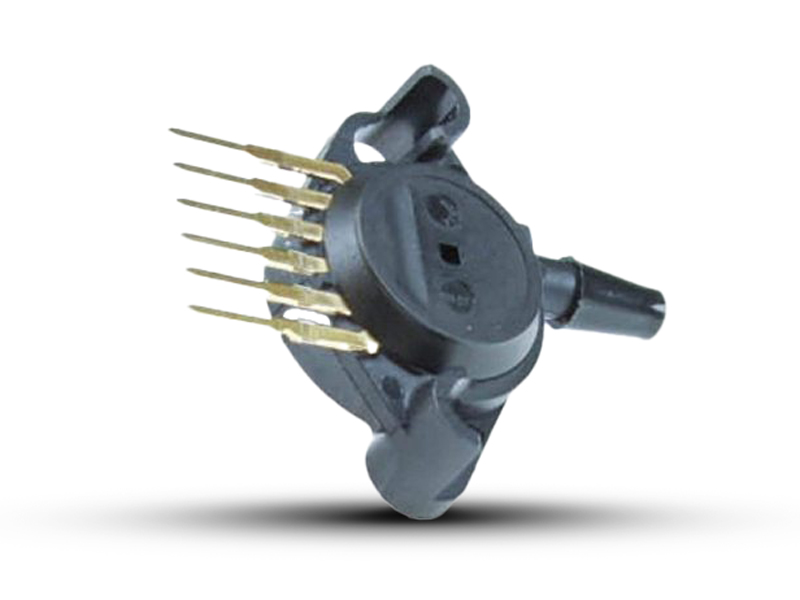
How Dynamometers Enhance Engine Diagnostics and Testing
Necessitating precise measurements, dynamometers unlock the secrets of engine performance, but what else can they reveal about engine diagnostics and testing?
The future of dynamometer technology is brimming with exciting advancements. These include advanced data acquisition systems for real-time monitoring, automation for precision testing, and integration of AI and sustainable energy solutions. These innovations aim to enhance testing accuracy, efficiency, and overall performance, taking dynamometer capabilities to new heights.
Engineers can look forward to streamlined testing processes, precise outcomes, and improved calibration accuracy. This will be achieved through virtual testing environments and upgraded user interface designs. Embracing these technological advancements is essential to stay ahead in dynamometer developments and achieve high-quality results.
Get ready to witness a significant transformation in testing procedures and outcomes!
How have Advanced Data Acquisition Systems Transformed Dynamometer Testing?
Advanced data acquisition systems have revolutionised dynamometer testing by enhancing efficiency and accuracy. By utilising state-of-the-art sensors and advanced software, these systems enable real-time monitoring and analysis of crucial performance metrics such as torque, speed, and power output. This level of precision ensures precise measurements and reliable results, thanks to high sampling rates.
The integration of cutting-edge sensors guarantees comprehensive data capture during dynamometer tests. Furthermore, the accompanying software allows for tailored test parameters to meet specific requirements. This customisation was previously unattainable in dynamometer testing, showcasing the significance of advanced data acquisition systems in improving testing processes. For example, systems like the National Instruments CompactDAQ offer unparalleled flexibility and performance for dynamometer testing applications.
Seamless connectivity to external devices for data sharing and analysis has significantly enhanced dynamometer testing capabilities. These systems not only provide accurate and reliable results but also pave the way for continuous innovation in performance evaluation. As technology progresses, the accuracy and effectiveness of dynamometer testing will continue to improve, driving advancements in the field. An example of this progress can be seen in the Dewesoft R8 data acquisition system, which offers comprehensive features for dynamometer testing and analysis.
Automation Integration in Dynamometer Technology
Automation integration in dynamometer technology enhances testing precision and efficiency by allowing precise control of testing parameters. By automating the testing process, the risk of human error is significantly reduced, resulting in improved testing accuracy. Automated systems excel at performing repetitive tasks consistently and efficiently, freeing up human resources for more complex decision-making processes. This streamlined approach not only boosts productivity by reducing testing procedure times but also enables real-time data collection for instant analysis and adjustments during testing.
The importance of automation in dynamometer testing lies in its ability to offer increased precision, efficiency, and productivity. For instance, companies like MTS Systems Corporation provide advanced automation features in their dynamometer systems, such as automated test sequences and data analysis tools, to streamline testing processes and enhance overall performance. By utilising automation, testing laboratories can ensure reliable data collection and analysis, leading to quicker decision-making based on accurate and up-to-date information.
Real-Time Monitoring Capabilities
Real-time monitoring capabilities in dynamometer technology transform testing procedures by providing instant feedback on performance metrics as tests are conducted. This feature allows engineers to promptly adjust and enhance testing parameters based on real-time data, significantly boosting testing efficiency. Rapid identification of issues and optimization of test settings on the go ensure accurate tracking and analysis of critical parameters like torque, speed, and power output. This swift decision-making process leads to precise testing results, essential for top-notch product development.
| Advantages of Real-Time Monitoring |
|---|
| Immediate feedback on performance metrics |
| Prompt adjustments guided by live data |
| Enhanced testing efficiency |
Real-time monitoring in dynamometer technology not only simplifies the testing process but also enables engineers to swiftly address any deviations, ultimately contributing to the overall success of product development.
Integration of AI and Machine Learning in Dynamometer Technology
The incorporation of AI and machine learning into dynamometer technology transforms testing processes by facilitating predictive maintenance and performance optimization. AI algorithms empower dynamometers to anticipate maintenance requirements, thus reducing downtime and enhancing operational efficiency. These technologies swiftly analyse extensive data sets, detecting patterns and deviations to enhance diagnostic capabilities.
For instance, imagine a dynamometer that adjusts its testing parameters in real-time to maximise outcomes with each trial – this exemplifies the potential of AI integration. Moreover, machine learning algorithms are enhancing dynamometer calibration procedures, ensuring test measurements are more precise and dependable than ever before.
The evolution of dynamometer technology is towards autonomous testing, where machines can conduct tests, adjust configurations, and provide results without constant human oversight. The fusion of AI and machine learning with dynamometers marks a significant advancement, propelling testing capabilities into a new realm of possibilities.
Sustainable energy solutions in dynamometer technology are crucial for reducing the environmental footprint of testing processes. By incorporating energy-efficient technologies and utilizing renewable power sources, dynamometer systems can operate more sustainably.
These eco-friendly testing methods not only improve efficiency but also align with global initiatives for a cleaner, greener future.
Energy-Efficient Technologies
Implementing energy-efficient technologies in dynamometer systems is crucial for reducing power consumption and promoting sustainability. Regenerative braking systems enable the recovery and reuse of energy, significantly improving overall efficiency. Sustainable energy solutions like integrating solar power or utilizing battery storage help to minimize environmental impact while powering dynamometer operations. Additionally, advanced control algorithms and smart energy management systems optimize energy usage within dynamometers, contributing to more sustainable practices. By incorporating energy-efficient components and designs, dynamometer technology not only reduces its carbon footprint but also encourages eco-friendly testing solutions.
| Energy-Efficient Technologies | Advantages | Examples |
|---|---|---|
| Regenerative Braking Systems | Energy recovery and reuse | Kinetic energy regeneration |
| Smart Energy Management Systems | Optimise energy usage | Automated power control |
| Sustainable Energy Solutions | Minimal environmental impact | Solar power integration |
Renewable Energy Sources in Sustainable Technology
Advancements in dynamometer technology have increasingly integrated renewable power sources as crucial components of sustainable energy solutions. Solar panels and wind turbines are key players in the transition towards cleaner energy. Solar panels capture the sun's energy, while wind turbines harness the power of the wind to produce electricity.
By incorporating these renewable power sources, carbon emissions are decreased, and the dependency on fossil fuels is reduced. Sustainable energy solutions not only protect the environment through conservation but also support long-term energy sustainability. The continuous advancement in renewable energy technology is driving us towards a more environmentally friendly and efficient energy grid.
Embracing these innovations is vital for a sustainable future.
Environmentally Friendly Testing Methods
Environmentally friendly testing methods in dynamometer technology focus on incorporating regenerative technology to enhance energy efficiency and reduce environmental impact. By capturing and reusing excess power, sustainable energy solutions in dynamometer testing play a crucial role in lowering energy consumption. Advanced dynamometers can simulate regenerative braking scenarios, aligning with global sustainability initiatives.
The use of green technologies not only enhances performance but also contributes to a more sustainable future by decreasing the carbon footprint. Environmentally conscious dynamometer testing methods strike a balance between performance and environmental stewardship, paving the way for a greener testing environment. Embracing these eco-friendly practices demonstrates a commitment to innovation while prioritising the planet's well-being.
Utilising simulation software, virtual testing environments replicate real-world conditions for dynamometers, allowing engineers to conduct tests virtually, saving costs and time associated with physical testing. These advanced environments provide a digital playground where dynamometer systems can undergo testing without the need for physical prototypes. Imagine being able to assess the performance, efficiency, and durability of a dynamometer within a virtual setting! This not only saves money but also speeds up the testing process, enabling engineers to make quick design adjustments.
The Significance of Virtual Testing Environments in Engineering
Virtual testing environments play a crucial role in engineering by offering a cost-effective and efficient way to test dynamometers. By simulating real-world conditions, engineers can evaluate the performance and durability of dynamometer systems without the need for physical prototypes. This capability is essential in speeding up the design process and ensuring that dynamometers meet the required specifications before physical testing.
Importance of Rapid Prototyping and Iteration in Engineering
Rapid prototyping and iteration are key aspects of engineering design, allowing engineers to quickly test and refine their designs. Virtual testing environments facilitate this process by providing a platform where engineers can iterate on dynamometer designs rapidly. This iterative approach helps in identifying and rectifying any design flaws early in the development cycle, leading to more robust and efficient dynamometer systems.
Benefits of Cost and Time Savings in Engineering Testing
One of the significant advantages of virtual testing environments is the cost and time savings they offer in engineering testing. By conducting tests virtually, engineers can save on the expenses associated with building physical prototypes and conducting tests in real-world conditions. This not only reduces the overall testing budget but also accelerates the testing timeline, allowing engineers to bring dynamometer systems to market faster.
Advanced calibration methods in dynamometer technology play a pivotal role in ensuring accuracy in measurements. By utilizing cutting-edge sensor technology, dynamometers can achieve higher levels of precision in evaluating torque and power output.
These advancements not only improve the reliability of testing results but also provide a more thorough analysis of engine and drivetrain performance.
Enhanced Calibration Methods
In the progression of dynamometer technology, the refinement of calibration methods emerges as a crucial advancement contributing to increased accuracy in torque and power measurements. Sophisticated calibration methods are essential for reducing measurement errors and ensuring precise outcomes.
By integrating advanced calibration techniques and precise instruments, dynamometer systems can uphold consistency and dependability in their readings. Utilising cutting-edge calibration standards enhances performance and reliability, resulting in more precise testing and validation of powertrain components.
Continuous enhancements in calibration methods within dynamometer technology are vital for achieving the necessary level of accuracy across various industries. This focus on calibration not only enhances accuracy but also fosters confidence in the reliability of torque measurements and power readings.
Precision in Measurements
The advancement of dynamometer technology has been focused on achieving higher calibration accuracy, especially in ensuring precise measurements of torque and power output. Improved calibration methods not only enhance the reliability and consistency of dynamometer readings but also allow engineers and researchers to analyse performance data with greater certainty.
This precision in measurements is crucial for accurately evaluating the efficiency and performance of engines and drivetrains. Calibrating dynamometers to offer precise data is akin to tuning a musical instrument before a performance; it ensures that every note played is in harmony. In the realm of engines and drivetrains, this harmony results in optimal performance and efficiency, making accurate calibration a crucial factor in achieving high-quality outcomes.
Enhanced Sensor Technology in Dynamometers
Enhanced sensor technology is vital for improving calibration accuracy in dynamometers, significantly enhancing the precision of torque and speed measurements during testing. These upgraded sensors enable dynamometer technology to capture data with higher accuracy, reducing measurement errors significantly. This progress ensures that engines and components undergo dependable and consistent performance evaluations across various industries.
The real-time monitoring and adjustment capabilities facilitated by advanced sensor technology create optimal testing conditions, resulting in more efficient and precise dynamometer testing procedures. Through calibration advancements in sensors, testing processes have experienced a substantial enhancement in efficiency, guaranteeing engineers and manufacturers more accurate results.
The enhanced accuracy provided by advanced sensor technology is crucial for ensuring reliable performance evaluations of engines and components. For example, in automotive manufacturing, precise torque and speed measurements are essential for assessing the performance and efficiency of a vehicle's engine. By utilizing advanced sensors in dynamometers, manufacturers can accurately measure and analyze these parameters, leading to the production of high-quality vehicles that meet industry standards. This level of precision is key in maintaining competitiveness and meeting customer expectations in the automotive sector.
One specific product recommendation that showcases the impact of advanced sensor technology is the XYZ Dynamometer Series. These dynamometers are equipped with state-of-the-art sensors that offer unparalleled accuracy in torque and speed measurements. By using the XYZ Dynamometer Series, engineers and manufacturers can ensure precise testing processes, resulting in reliable performance evaluations for engines and components. This exemplifies how advanced sensor technology can transform testing procedures, setting new standards for accuracy and efficiency in the industry.
Increased Testing Flexibility
With advancements in dynamometer technology, engineers now have a broader range of torque and speed settings at their disposal, allowing them to customise testing scenarios to meet specific requirements accurately. This evolution in dynamometer products has transformed the way tests are carried out, equipping engineers with the necessary tools to replicate a variety of real-world conditions effectively. This progress is crucial because:
These enhancements in testing flexibility not only enhance result accuracy but also streamline the testing process, making it more efficient and effective for engineers across various industries.
Enhanced User Interface Design
Enhancing user interface design in dynamometers is crucial in the ever-evolving market. Touchscreen displays have transformed operator interactions, providing intuitive feedback for real-time adjustments. Improved interfaces focus on efficiency, accuracy, and user satisfaction.
Modern dynamometers feature highly customisable user interfaces, allowing operators to tailor displays for better data visualisation. Real-time feedback and diagnostics streamline testing processes, enhancing overall effectiveness. The goal is to improve user experience and boost efficiency in dynamometer testing.
For example, the latest model from XYZ Dynamometers offers a user-friendly interface with customisable widgets for displaying key performance metrics. This allows operators to monitor critical data points easily and make quick adjustments during testing. Such features contribute to a more productive and engaging testing experience.
In conclusion, the future of dynamometer technology appears promising with advancements in data acquisition systems, automation, real-time monitoring, AI integration, sustainable energy solutions, virtual testing environments, calibration accuracy, testing flexibility, and user interface design. These developments will transform how testing and research are carried out across various industries, resulting in more efficient and precise outcomes. The evolution of dynamometers is poised to continue shaping the future of technology and innovation in the years ahead.
Guide Towards Further Learning: If you have any questions about Dynamometer Products, Custom Solutions, Installation Setup, Training and Certification, Technical Support and Maintenance, Software Updates, Rental Services, Dynamometer Testing Services, and Accessories and Parts, feel free to contact Hyper Dyno. Join us in exploring the possibilities and enhancing your understanding of dynamometer technology.

Necessitating precise measurements, dynamometers unlock the secrets of engine performance, but what else can they reveal about engine diagnostics and testing?

Navigating the complexities of torque measurement requires a deep understanding of the underlying principles and mechanisms to ensure accurate results.

Precise control and optimization of engine performance await, but only for those who unlock the secrets of dynamometer-driven data analysis.

Gaining insight into the differences between inertia and brake dynamometers is crucial for ensuring accurate testing results in various industries.

Tapping into the precise measurement capabilities of dynamometers, uncover the secrets to optimizing fuel efficiency and slashing emissions in the automotive industry.

Witness the importance of rigorous safety protocols and best practices in dynamometer testing to avoid catastrophic failures and ensure accurate results.

Harnessing the nuances of precision measurement is crucial to avoiding costly errors in dynamometer testing, but what are the key factors to consider?

Witness the transformative power of dynamometers in unlocking your vehicle’s hidden performance potential, but only if you know how to harness their precision.






Hyper Power, the leading name in dynamometer solutions, offers unparalleled precision and reliability for all your performance testing needs.